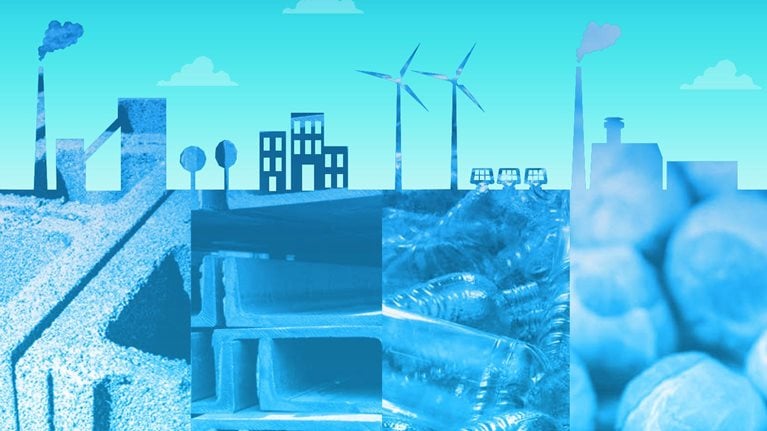In the mining industry, the impact of climate change and how the industry can respond to it has increasingly been a topic of discussion over the past decade.
Mining is no stranger to harsh climates; much of the industry already operates in inhospitable conditions. But forecasts of hazards such as heavy precipitation, drought, and heat indicate these effects will get more frequent and intense, increasing the physical challenges to mining operations.
Under the 2015 Paris Agreement, 195 countries pledged to limit global warming to well below 2.0°C, and ideally not more than 1.5°C above preindustrial levels. That target, if pursued, would manifest in decarbonization across industries, creating major shifts in commodity demand for the mining industry and likely resulting in declining global mining revenue pools. Mining-portfolio evaluation must now account for potential decarbonization of other sectors.
The mining sector itself will also face pressure from governments, investors, and society to reduce emissions. Mining is currently responsible for 4 to 7 percent of greenhouse-gas (GHG) emissions globally. Scope 1 and Scope 2 CO2 emissions from the sector (those incurred through mining operations and power consumption, respectively) amount to 1 percent, and fugitive-methane emissions from coal mining are estimated at 3 to 6 percent.1 A significant share of global emissions—28 percent—would be considered Scope 3 (indirect) emissions, including the combustion of coal.
To address climate risk, mining companies can focus on three areas: which assets are most at risk from physical climate change; how decarbonization could shift demand for key minerals; and how miners can decarbonize their own operations.
The mining industry has only just begun to set emission-reduction goals. Current targets published by mining companies range from 0 to 30 percent by 2030, far below the Paris Agreement goals.2 Mines theoretically can fully decarbonize (excluding fugitive methane) through operational efficiency, electrification, and renewable-energy use. Capital investments are required to achieve most of the decarbonization potential, but certain measures, such as the adoption of renewables, electrification, and operational efficiency, are economical today for many mines.
To address climate risk for miners, we examine three questions in this article: Which mining assets are most at risk from physical climate change? How could decarbonization shift demand for key minerals? And how can mining companies decarbonize their own operations? We then lay out the operational, investment, and portfolio options that mining executives can use to create an actionable climate strategy and set ambitious targets.
Vulnerable mining assets
Despite changing climate conditions, options exist to improve the resiliency of mining assets to certain physical effects. We evaluated the impact of water stress and flooding in detail and suggest how operators might mitigate these risks.
Water stress
Climate change is expected to cause more frequent droughts and floods, altering the supply of water to mining sites and disrupting operations. We recently ran and analyzed a water-stress and flooding scenario using McKinsey’s MineSpans database on copper, gold, iron ore, and zinc.3
We found that today, 30 to 50 percent of production of these four commodities is concentrated in areas where water stress is already high.4 In 2017, these sites accounted for roughly $150 billion in total annual revenues and were clustered into seven water-stress hot spots for mining: Central Asia, the Chilean coast, eastern Australia, the Middle East, southern Africa, western Australia, and a large zone in western North America.
Climate science indicates that these hot spots will worsen in the coming decades.5 In Chile, 80 percent of copper production is already located in extremely high water-stressed and arid areas; by 2040, it will be 100 percent. In Russia, 40 percent of the nation’s iron ore production, currently located in high water-stressed areas, is likely to move to extreme water stress by 2040.
Mining regions not accustomed to water stress are projected to become increasingly vulnerable. By 2040, 5 percent of current gold production will likely shift from low–medium water stress to medium–high, 7 percent of zinc production could move from medium–high to high water stress, and 6 percent of copper production could shift from high to extremely high water stress (Exhibit 1). Depending on the water intensiveness of the processing approach, such changes, while seemingly minor in percentage terms, could be critical to a mine’s operations or license to operate.

Mining executives in these regions are acutely aware of the water issue. For instance, Leagold Mining recently shut down its RDM gold mine in Brazil for two months because of drought conditions, even though it had built a dam and a water pipeline. Even in areas with low water stress, certain water-intensive mining processes are jeopardized. In Germany—not a country known for being vulnerable to drought—a potash miner was forced to close two locations because of severe water shortages in the summer of 2018, losing nearly $2 million a day per site. The frequency and severity of these conditions are expected to increase along with the current climate trajectory.
Since water stress is likely to increase at different rates from place to place, mining executives will need to look at local water-stress projections for their individual sites and determine where the worst effects are likely to occur.
To improve resiliency, companies can reduce the water intensity of their mining processes. They can also recycle used water and reduce water loss from evaporation, leaks, and waste. Anglo American improved evaporation monitoring at its Drayton mine dam in Australia, for example. Mining companies can prevent evaporation by putting covers on small and medium dams.
In the long term, more capital-intensive approaches are also possible. New water infrastructure, such as dams and desalination plants, is expensive but sometimes necessary. Companies can also rely on so-called natural capital, like wetland areas, to improve groundwater drainage.
The option of securing water rights is becoming harder and can take years of engagement because of increased competition for natural resources and tensions between operators and local communities. Basin and regional planning with regulatory and civic groups is an important strategy but cannot alone solve the underlying problem of water stress.
Flooding
Flooding from extreme rains can also cause operational disruptions, including mine closure, washed-out roads, and unsafe water levels in tailing dams. At one open-pit coal mine, we observed 10 percent annual production losses from wet weather. Flooding affects some commodities more than others, based on their location; in our analysis, iron ore and zinc are the most exposed to extremely high flood occurrence, at 50 percent and 40 percent of global volume, respectively.6
The problem is expected to get worse, particularly in six “wet spots” likely to experience a 50 to 60 percent increase in extreme precipitation this century: northern Australia, South America, and southern Africa during Southern Hemisphere summer, and central and western Africa, India and Southeast Asia, and Indonesia during Southern Hemisphere winter.
To address high-water concerns, companies can adopt flood-proof mine designs that improve drainage and pumping techniques. They can adapt roads (such as by using hard metal or crusted rock for speed drying) or build sheeted haul roads, as First Quantum Minerals did at its Sentinel copper mine in Zambia. They can also use conveying methods that don’t rely on trucking (such as by creating a full in-pit crushing and conveying system).
Other climate factors
Extreme weather combined with sea-level rise can damage processing or transportation infrastructure located near coastlines.
Extreme heat in already hot places—particularly Australia, China, and parts of North and West Africa—can decrease worker productivity and raise cooling costs. It can also put workers’ health (and sometimes their lives) at risk. Indirect socioeconomic consequences from climate change can also affect the political environment surrounding a mine.
Extreme heat in already hot places—particularly Australia, China, and parts of North and West Africa—can decrease worker productivity and raise cooling costs. It can also put workers’ health (and sometimes their lives) at risk. Indirect socioeconomic consequences from climate change can also affect the political environment surrounding a mine.
Shifting demand for minerals
Significant growth of low-carbon technologies will occur if industries commit to cutting emissions in line with Paris Agreement targets. Technologies that support decarbonization include wind turbines, solar photovoltaics, electric vehicles, energy storage, metal recycling, hydrogen fuel cells, and carbon capture and storage.
The mining industry will be part of the decarbonization solution by providing the raw materials needed for these technologies. Simultaneously, their growth will alter demand patterns for upstream mining commodities.
We developed a theoretical commodity-demand-shift scenario, quantifying the impact on commodity demand by 2030, assuming global warming is limited to 2°C (Exhibit 2). Because the exact scale and mix of decarbonization technologies in a 2°C scenario is far from certain, the demand shifts are displayed as directional movements when compared with business-as-usual forecasts.

Coal, currently about 50 percent of the global mining market, would be the most obvious victim of such shifts. Decarbonization of the power sector would mean taking net GHG emissions to zero, implying an almost complete reduction in the combustion of coal. And if metal companies switch to hydrogen and biofuels as energy sources, demand for metallurgical coal will weaken. While coal demand is still rising, capital investments in coal mines have become more difficult, with public opinion hardening and some banks pulling away from the industry in certain regions.
More energy-efficient processing and widespread recycling would put pressure on virgin-ore markets. In a 2°C scenario, bauxite, copper, and iron ore will see growth from new decarbonization technologies offset by increased recycling rates, as a result of the growing circular economy and focus on metal production from recycling versus virgin ore.
At the other end of the spectrum, niche minerals could experience dramatic growth. As the global electrification of industries continues, electric vehicles and batteries will create growth markets for cobalt, lithium, and nickel. Emerging technologies such as hydrogen fuel cells and carbon capture would boost demand for platinum, palladium, and other catalyst materials, while rare earths would be needed for wind-turbine magnets.
Fully replacing revenues from coal will be difficult. Yet many of the world’s biggest mining companies will need to rebalance nondiverse mineral portfolios. Many of the largest mining companies derive the bulk of their earnings from one or two commodities. Copper-heavy portfolios may benefit from demand growth related to widespread electrification, for example. And iron ore– and aluminum-heavy portfolios may see an upside from decarbonization technologies, but they are also more likely to be hit by rising recycling rates.
Niche commodities probably will not be able to replace the magnitude of earnings from coal, but they could help manage losses (Exhibit 3). For miners, a rebalanced portfolio would require agility—sophisticated market intelligence and flexible assets—which could become a competitive advantage in enabling responses to mineral-demand shifts.

There is a growing interest in low-carbon metals from downstream-production processes. For example, some automotive companies that manufacture products using a carbon-neutral process are asking suppliers to deliver carbon-neutral parts, often made with niche metals. Technology giant Apple has announced the purchase of carbon-free aluminum for its products. Although metals are not yet priced on their CO2 footprint, that day could come.
A legislated carbon price could also shift the competitive dynamics. A local price on carbon—in any form—affects advantages in different mining regions, commodities, processing routes, and companies. In Europe, for example, the Emission Trading System (ETS) is entering a new phase of emission-reduction targets. The so-called Green Deal on emission regulations, while in its early stages, could lead to a higher carbon price for European primary industries, resulting in possible competitive disadvantages for some companies in global markets.
Besides shifting commodity demand, major reductions in carbon emissions would also affect commodity prices. A global carbon price, investments to decarbonize operations, and strong growth in commodities requiring the opening of new mines would increase mining costs, leading to higher commodity prices. The commodities at stake and the potential price growth are functions of how and at what pace decarbonization occurs.
How mining can decarbonize
The mining industry generates between 1.9 and 5.1 gigatons of CO2 equivalent (CO2e) of GHG emissions annually. The majority of emissions in this sector originate from fugitive coal-bed methane that is released during coal mining (1.5 to 4.6 gigatons), mainly at underground operations.7 Power consumption in the mining industry contributes 0.4 gigaton of CO2e.
Further down the value chain—what could be considered Scope 3 emissions8—the metal industry contributes roughly 4.2 gigatons, mainly through steel and aluminum production. Coal combustion for the power sector contributes up to roughly ten gigatons of CO2.
Any serious effort to implement Paris Agreement goals would require a major contribution from the entire value chain. To stay on track for a global 2°C scenario, all sectors would need to reduce CO2 emissions from 2010 levels by at least 50 percent by 2050.9 To limit warming to 1.5°C, a reduction of at least 85 percent would likely be needed.10 Mining companies’ published emission targets tend to be more modest than that, setting low targets, not setting targets beyond the early 2020s, or focusing on emission intensity rather than absolute numbers.
External pressure to decarbonize depends on a mix of factors, including involvement by investors, regulators, and customers. Decarbonization will also vary by geography, segment, and executives’ own priorities. The Task Force on Climate-related Financial Disclosures (TCFD), a coalition with support from more than 300 investors with nearly $34 trillion in assets under management, recommends that companies report their “transition risks” under a 2°C decarbonization scenario.
Decarbonizing the mining industry would require a serious effort by the coal industry, particularly in tackling fugitive methane. Solutions for capturing methane (and using it to generate power) exist, but they are not commonly implemented. In the United States, for instance, the Coalbed Methane Outreach Program—part of the Environmental Protection Agency—works with the coal-mining industry to support project development and to overcome technical and other barriers to implementation. But there are no ready solutions for all types of mines, and the investment is not economical in many cases.
To create a baseline of current mining emissions, we overlaid our MineSpans database of mines’ operational characteristics with emission factors by fuel source (Exhibit 4). Across commodities, electricity usage amounts to 0.3 gigaton and diesel to roughly 0.1 gigaton.

We then estimated the possible impact of, and constraints on, several mining-decarbonization levers (Exhibit 5).

The decarbonization potential for mines varies by commodity, mine type, power source, and grid emissions, among other factors. Across the industry, noncoal mines could fully decarbonize by using multiple levers. Some are more economical than others—operational efficiency, for example, can make incremental improvements to the energy intensity of mining production while requiring little capital expenditure.
Moving to renewable sources of electricity is becoming increasingly feasible, even in off-grid environments, as the cost of battery packs is projected to decline 50 percent from 2017 to 2030. Codelco, for instance, uses solar power for one of its copper mines in Chile, and Fortescue Metals is investing in renewable energy at its iron ore mines in the Pilbara region in Australia. BHP recently signed contracts for renewable energy at its Escondida and Spence copper mines.
Electrification of mining equipment, such as diesel trucks and gas-consuming appliances, is only starting to become economical. Right now, only 0.5 percent of mining equipment is fully electric. However, in some cases, battery electric vehicles have a 20 percent lower total cost of ownership versus traditional internal-combustion-engine vehicles. Newmont, for example, recently started production at its all-electric Borden mine in Ontario, Canada.
Some decarbonization actions will benefit the bottom line, while others will prioritize social responsibility. Future regulatory and technological developments may change the viability of certain actions, but one thing is certain: the business case will vary for each mine—and each company.
To date, mining companies have viewed sustainability mostly through a local lens, but achieving a 1.5°C to 2.0°C pathway will require significant global action. Several big mining companies have installed their own sustainability committees, signaling that mining is joining the wave of corporate sustainability reporting and activity. Reporting emissions and understanding decarbonization pathways are the first steps toward setting targets and taking action.
A checklist for top executives
To respond to the impact of climate change, mining executives should take five main actions.
First, perform an end-to-end diagnostic of climate change’s effects on the business so that you know which assets to protect from physical climate change and which stand to gain or lose from decarbonization. The physical risks of climate change, such as water stress, precipitation, and heat, must be evaluated at a localized, asset-specific level. Such analyses may require technical expertise from outside the organization, tailored to the company’s specific footprint and operations.
Decarbonization scenarios should be built into demand forecasts for a company’s commodities, including accounting for at-scale renewables, metal recycling, and even metal-process-route shifts. Site-specific baseline emissions should be understood, and potential abatement levers evaluated.
Second, mobilize the C-suite and the board. Climate change—the risks and the opportunities—should be considered a board-level topic, given its systemic, long-term, and potentially dramatic impact. Ambitious climate targets that come from the top—an approach the mining sector is only beginning to embrace—can create value and spur employee and stakeholder engagement.

Climate risk and response: Physical hazards and socioeconomic impacts
Third, focus on operational transformation, investments, and innovation. Several percentage points of no-regrets energy-efficiency moves can often be found at mines, and climate targets can focus efforts to unearth them. Shifting to renewables can offer benefits, such as lower electricity costs and reduced volatility. Bolder investments—such as reimagining processes to account for shifting water demand and embarking on a decarbonization plan using both existing technologies and promising new alternatives—may also be made.
Fourth, evaluate and potentially reshape your portfolio. Climate change introduces unpredictability, requiring “climate intelligence” to be embedded in decision-making processes, such as capital allocation. The ability to move relatively quickly in or out of niche materials will become valuable.
Fifth, continue to engage through reporting, partnerships, and other proactive measures. Some investors, such as those signed with the TCFD, now require climate-risk disclosures; this will become more important as climate expectations mature. Such reporting can serve as a forcing device for internal change. Industry coalitions—including peers, customers, suppliers, and society at large—can aid engagement. Additionally, an ambitious agenda on one of society’s most difficult goals can be motivational for employees and external stakeholders alike.
Mining companies are reviewing commodity portfolios, setting targets, and engaging with stakeholders. Yet these actions may not be keeping up with society’s expectations—as increasingly voiced by investors seeking disclosures, companies asking their suppliers to decarbonize, and communities advocating for action on environmental issues.
Action on climate change is growing in the mining industry, as companies review commodity portfolios, set targets, and engage with stakeholders.
Yet these actions are too modest to reach the 1.5°C to 2.0°C scenario and may not be keeping up with society’s expectations—as increasingly voiced by investors seeking disclosures, companies asking their suppliers to decarbonize, and communities advocating for action on environmental issues. Mining companies concerned about their long-term reputation, “license to operate,” or contribution to decarbonization efforts may start to consider more aggressive decarbonization and resilience plans.


